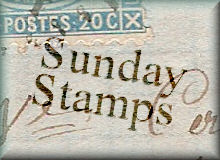The stamp design is by Arone Raymond Meeks drawing on his Aboriginal heritage, the back of the envelope explains:
"it depicts our ancient land being cradled and protected by a Creation Ancestor, called a Wandjina. In the Wandijina's hand, an egg symbolises perfection and rebirth, an ideal which all Australians can aspire. A Rainbow Serpent, also a Creation Ancestor, runs through the Wandjina's body, its tongue forming the Wandjina's eyes".The cover photograph shows the Walls of China in the Mungo National Park (in south-western New South Wales); a series of lunette (crescent shaped sand dunes). For photographs of Walls of China lunettes see here
The area was declared a world heritage site in 1981 and is of great significance to the Aborigine people who settled here 40,000 years ago. The Walls of China lie east of the dry Lake Mungo where there have been remarkable archaeological finds of ancient people which have been named Mungo man and Mungo women. The ultimate footprints in the sands have been found by archaeologists - the world's largest number of human footprints in the dry lakes dating back to the ice age, about 20,000 years ago.
An entry to Viridian Postcard's Sunday Stamps










 .
.





